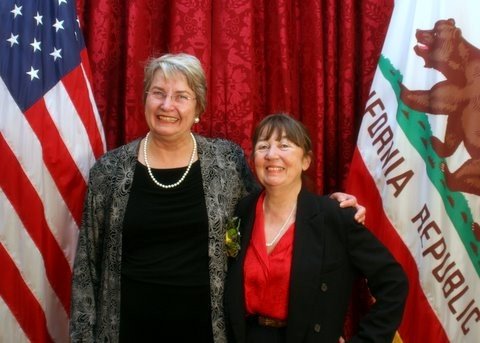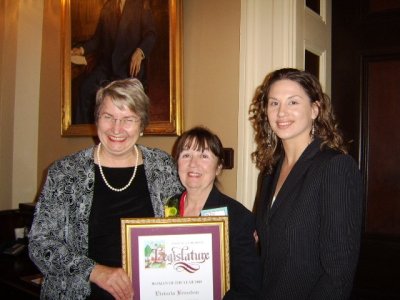
The Upper Lake 2008 team: Top of picture, Coach Lance Kraft. First row (left to right): Marisa Garcia, Hannah Johnson and Kyle Coleman; second row, Corey Smith, Robin Grayhorse, Laura Benavides, Maria Mendoza and Coach Christina Moore; bottom row, Daniella Cazares and Robert Pyle. Photo by Robert Riggs.
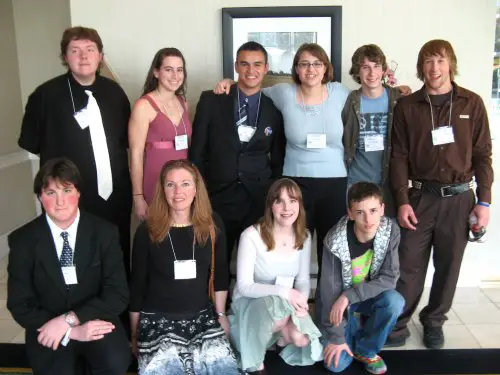
The Lower Lake 2008 squad: top row (left to right), Daniel Jackson, Emmalina Illia, Josh Salazar, Kayla Myrick, Chris Ingersoll and Jacob Sanders. Bottom row: Gerald Skinner, Coach Nancy Harby, Kate Lyons and Joe Riggs. Photo by Robert Riggs.
LAKE COUNTY – By the time the state Academic Decathlon was all over on Monday, Lake County's two top teams had brought home an impressive score of medals. {sidebar id=63}
Upper Lake High School, winner of the county Academic Decathlon competition Feb. 2, and second-place county finisher Lower Lake – which won a special invitation to the state for its high score – went to Sacramento for the 2008 California Academic Decathlon, which took place Saturday through Monday.
This year's theme was the Civil War.
Upper Lake and Lower Lake competed in the small schools' Division III, bringing home more than two dozen medals (see the accompanying full medal count).
Neither team finished in the top three trophy slots, although they were close. Upper Lake Coach Christina Moore said Upper Lake scored 34,088.2, just 175.1 points shy of catching third-place finisher Mountain Oaks Charter High of Calaveras.
Lower Lake Coach Nancy Harby said her team had an overall score of 33,220.7, and were a few slots behind Upper Lake. The team also finished fourth overall in the Super Quiz.
“We did great,” said Harby.
The overall California Academic Decathlon title was won by Moorpark High School from Ventura, California. Moorpark is a Division I school that will go on to compete in the United States championships in Garden Grove, California at the end of March.
Division II was won by Casa Grande High of Petaluma, while Division III was won by Marysville High.
Each Academic Decathlon team is separated into three parts: Honor, for students with a grade point average (GPA) at 3.75 or above; Scholastic, with a 3.00 to 3.74 GPA; and Varsity with a 2.99 or below GPA. Three students from each group participate on each team.
Upper Lake team members for 2008 include: Varsity – Robert Pyle, Corey Smith and Maria Mendoza; Scholastic – Robin Grayhorse, Hannah Johnson and Laura Benavides; Honor – Daniella Cazares, Kyle Coleman and Marisa Garcia. Coaches are Christina Moore and Lance Kraft.
Lower Lake's team included: Varsity – Chris Ingersoll, Jacob Sanders and Gerald Skinner; Scholastic – Kayla Myrick, Joe Riggs and Joshua Salazar; Honor – Kate Lyons, Daniel Jackson and Emmalena Illia; alternates – Ryan Wilson, Alexandra Huff, Sean Grant and Jeremy Montano. Nancy Harby coaches the team.
Amongst local competitors, Upper Lake's Robert Pyle stole the show with a total of 10 medals. Moore said he won the overall gold medal honor as the highest scorer among all California Division III school participants in the Varsity division, plus two fists full of medals for everything from music and art to science and mathematics.
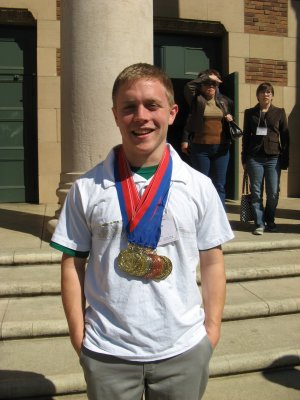
Upper Lake's Robert Pyle, won 10 medals, including earning the gold medal as the highest scorer among all California Division III schools participants in the Varsity division. Photo by Robert Riggs.
For Upper Lake, Honor level competitor Marisa Feliciano Garcia won a gold medal for essay, while Daniella Santana Cazares won a silver medal for essay.
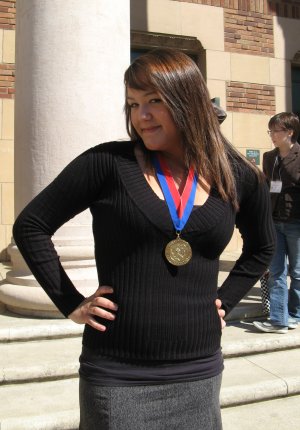
Marisa Garcia of Upper Lake proudly displays her gold medal won in essay. Photo by Robert Riggs.
Cougar Corey Smith, in the Varsity division, won a silver medal for language and literature and a bronze medal for music. Laura Benavides, Scholastic, won silver medals for science and language and literature, and Maria Mendoza, Varsity, was awarded a bronze medal for her interview.
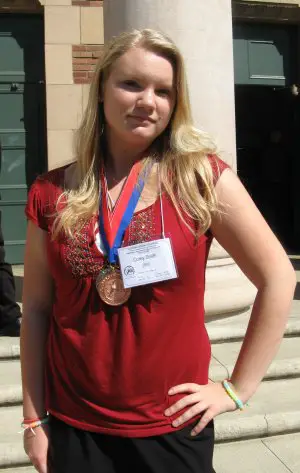
Upper Lake's Corey Smith, competing in the Varsity division, won a silver medal for language and literature, and a bronze medal for music. Photo by Robert Riggs.
Upper Lake senior Robin Grayhorse, at the Scholastic level, won bronzes in science and for the Super Quiz.
Grayhorse also won a $2,000 College Access Foundation scholarship, a new addition to the competition that is based both on need and points scored, said Moore. At the county level, Pyle and Mendoza won $2,200 scholarships, which meant they did not qualify for the state-level award.
“We were very, very happy,” Moore said of her team's efforts.
In the segment of the Super Quiz competition conducted for public viewing at the Sacramento Memorial Auditorium, Upper Lake and Lower Lake each scored 35 points. Their scores in that portion of the competition topped those of several larger schools from Lake County’s neighbors, including Novato (Marin County), St. Helena (Napa County) and Maria Carrillo of Santa Rosa.
Just to compete at the state level is a great opportunity, said Moore, and her students had a good time, and studied and learned a lot – including the valuable skill of working in a team.
“It's a wonderful thing to see,” she said.
Moore believes that the 18 medals brought home to Upper Lake may be the highest number her team has achieved at state. The team has made almost yearly treks to the state competition over the last decade.
Although Lake County News was unable to catch up with Upper Lake students on Monday, Lower Lake senior Kate Lyons reported having a great time at her last competition, saying her performance was “much better” than last year's.
“I knew what to do,” she said. “This was my third time at state competition.”
Lyons finished as the second highest scorer among all California Division III schools in the Honors division. Lyons’ medal list included golds for music, speech and team high scorer, and bronzes for history, science and the Super Quiz.
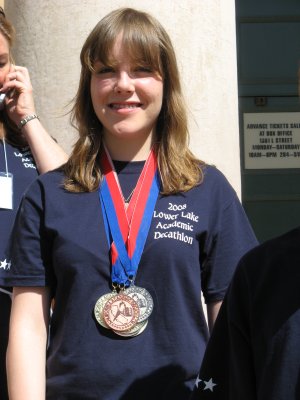
Lower Lake senior Kate Lyons was the second highest scorer among all California Division III schools in the Honor division and won a total of six medals. Photo by Robert Riggs.
Lower Lake Sophomore Joe Riggs, competing for the Trojans in the Scholastic division, won gold medals for economics and in the Super Quiz. Riggs also won a silver medal for art.
Trojan Kayla Myrick, an Honor participant, won a gold medal for her interview. Scholastic entrant Joshua Salazar won a gold medal for science and a silver medal for interview, while Gerald Skinner, competing at the Varsity level, won a silver medal for science.
Myrick and Jake Sanders – both seniors who made their first Academic Decathlon appearances this year – reported a fun but challenging experience, with the opportunity to meet new people.
Sanders said he joined the team to improve his study skills for college. He plans to start at Santa Rosa Junior College next year, with Myrick heading off to University of California, Davis.
“The overall experience was one of the most memorable of my high schools years, that's for sure,” Sanders said.
For the younger class members who will continue forward in the Academic Decathlon next year, it will soon be time to start cracking the books once more. Next year's theme, said Moore, has already been chosen.
The topic? Mexico.
Elizabeth Larson contributed to this report.

Lower Lake team members await the next question in the Super Quiz event at the Sacramento Memorial Auditorium on Sunday, March 9, 2008. Photo by Robert Riggs.
{mos_sb_discuss:2}









